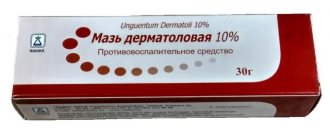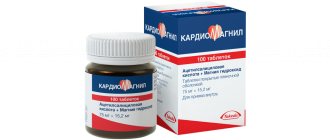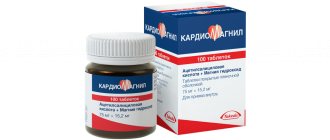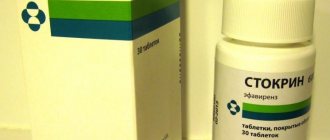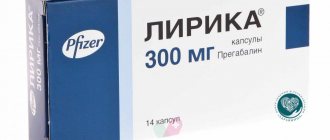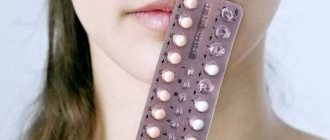Pharmacological action, pharmacodynamics and pharmacokinetics
Polyoxidonium has detoxification and immunocorrective effects. It increases the body's immune defense and helps it more effectively fight diseases of viral, fungal and bacterial etiology.
The mechanism of action of the drug is based on the ability of the main substance to influence natural killer cells and phagocytes, as well as stimulate antibody formation.
Taking Polyoxidonium together with other medications makes treatment more effective, reduces its duration, and sometimes allows you to completely stop using antibacterial, bronchodilator and hormonal drugs.
The main active ingredient has a high bioavailability of up to 90%. Azoximer bromide quickly enters and distributes into tissues. Excreted from the body through the kidneys.
Instructions for use of the drug Polyoxidonium®, solution for injection and topical use
Azoximer bromide has a complex effect: immunomodulatory, detoxifying, antioxidant, moderate anti-inflammatory. The basis of the mechanism of immunomodulatory action of Azoximer bromide is a direct effect on phagocytic cells and natural killer cells, as well as stimulation of antibody formation and the synthesis of interferon-alpha and interferon-gamma. The detoxification and antioxidant properties of Azoximer bromide are largely determined by the structure and high-molecular nature of the drug. Azoximer bromide increases the body's resistance to local and generalized infections of bacterial, fungal and viral etiology. Restores immunity in secondary immunodeficiency conditions caused by various infections, injuries, complications after surgery, burns, autoimmune diseases, malignant neoplasms, the use of chemotherapeutic agents, cytostatics, steroid hormones. The use of the drug Polyoxidonium® against the background of secondary immunodeficiency states can increase the effectiveness and shorten the duration of treatment, significantly reduce the use of antibiotics, bronchodilators, glucocorticosteroids, and extend the period of remission. The inclusion of the drug Polyoxidonium® in the complex therapy of cancer patients reduces intoxication during chemotherapy and radiation therapy, in most cases allows for standard therapy without changing the regimen due to the development of infectious complications and side effects (myelosuppression, vomiting, diarrhea, cystitis, colitis and others ). A characteristic feature of Azoximer bromide when applied locally (intranasally, sublingually) is the ability to activate factors of the body's early defense against infection: the drug stimulates the bactericidal properties of neutrophils, macrophages, enhances their ability to absorb bacteria, increases the bactericidal properties of saliva and secretions of the mucous membranes of the upper respiratory tract. Azoximer bromide blocks soluble toxic substances and microparticles, has the ability to remove toxins and heavy metal salts from the body, and inhibits lipid peroxidation both by intercepting free radicals and by eliminating catalytically active Fe2+ ions. Azoximer bromide reduces the inflammatory response by normalizing the synthesis of pro- and anti-inflammatory cytokines. Azoximer bromide is well tolerated, does not have mitogenic, polyclonal activity, antigenic properties, does not have allergenic, mutagenic, embryotoxic, teratogenic and carcinogenic effects. Azoximer bromide is odorless and tasteless, and does not have a local irritant effect when applied to the mucous membranes of the nose and oropharynx.
Indications and contraindications
Depending on the dosage form, Polyoxidonium can be prescribed for various pathological conditions. Doctors recommend taking the tablets for:
- Diseases of an inflammatory and infectious nature localized in the mouth, sinuses, ear, and upper respiratory tract.
- Secondary immunodeficiencies as a prophylactic agent during periods of increased incidence of viral and bacterial infections.
Indications for use of lyophilized powder:
- Intravenous or intramuscular administration for diseases of inflammatory or infectious nature.
- Rheumatoid arthritis (if the patient was treated with drugs that suppress the immune system).
- Tuberculosis.
- Allergic diseases complicated by severe, recurrent infection.
- After radiation or chemotherapy for oncological conditions.
- Reducing nephro- and hepatotoxicity of drugs.
- Prevention of influenza and acute respiratory viral infections during epidemics.
- Complicated bronchial asthma.
- Atopic dermatitis accompanied by purulent infection.
- Gastrointestinal diseases with dysbacteriosis.
Indications for the use of rectal and vaginal suppositories are the same as for lyophilisate. In addition, they are used to treat a wide range of gynecological pathologies (erosion, colpitis, endometritis, etc.).
There is only one contraindication to the use of Polyoxidonium. It should not be taken only by persons with high hypersensitivity to the components of the drug. It is also rarely prescribed to pregnant women due to the lack of data on the effect of the drug on the fetus.
Polyoxidonium®
Methods of using the drug Polyoxidonium®: parenteral (intramuscular, intravenous), intranasal, sublingual.
Methods of application, dosage regimen, need and frequency of subsequent courses of therapy are selected by the doctor depending on the severity of the disease and the age of the patient.
For intravenous drip administration, the dose of the drug calculated for the patient is sterilely transferred from a syringe into a bottle/bag with 0.9% sodium chloride solution. The prepared solution for intravenous administration cannot be stored.
Recommended treatment regimens for adults:
Parenteral (intramuscular or intravenous): the drug is prescribed to adults in doses of 6-12 mg 1 time per day every day, every other day, or 1-2 times a week, depending on the diagnosis and severity of the disease.
For acute viral and bacterial infections of the ENT organs, upper and lower respiratory tract, gynecological and urological diseases: 6 mg daily for 3 days, then every other day for a total course of 10 injections.
For chronic recurrent infectious and inflammatory diseases of various localization, bacterial, viral and fungal etiology, in the acute stage: 6 mg every other day for 5 injections, then 2 times a week for a total course of 10 injections.
For acute and chronic allergic diseases (including hay fever, bronchial asthma, atopic dermatitis), complicated by bacterial, viral and fungal infections: 6-12 mg, course of 5 injections, every other day.
For rheumatoid arthritis, complicated by bacterial, viral and fungal infections, against the background of long-term use of immunosuppressants: 6 mg every other day for 5 injections, then 2 times a week for a total course of 10 injections.
For generalized forms of surgical infections: 6 mg daily for 3 days, then every other day for a total course of 10 injections.
To activate regenerative processes (fractures, burns, trophic ulcers): 6 mg for 3 days, then every other day, for a total course of 10 injections.
For the prevention of postoperative infectious complications: 6 mg every other day, 5 injections.
For pulmonary tuberculosis: 6 mg 2 times a week for a course of 20 injections.
In cancer patients:
- before and during chemotherapy to reduce the immunosuppressive, hepato- and nephrotoxic effects of chemotherapeutic agents, mg every other day for a course of 10 injections; further, the frequency of administration is determined by the doctor depending on the tolerability and duration of chemotherapy and radiation therapy;
- to prevent the immunosuppressive effect of the tumor, to correct immunodeficiency after chemotherapy and radiation therapy, after surgical removal of the tumor, long-term use of the drug Polyoxidonium® (from 2-3 months to 1 year) 6 mg 1-2 times a week is indicated. When prescribing a long course, there is no effect of accumulation, toxicity or addiction.
Intranasal or sublingual (see section “Rules of use for sublingual and intranasal administration”):
- for the treatment of acute and exacerbations of chronic infections of the ENT organs;
- for the treatment and prevention of influenza and ARVI;
- to enhance the regenerative processes of mucous membranes;
- for the prevention of complications and relapses of chronic diseases. The total volume of the drug per day is 1 ml (20 drops) - 6 mg/ml syringe.
The daily dose of the drug is administered intranasally or sublingually in 3-4 doses per day.
Recommended treatment regimens for children:
Parenterally (intramuscularly or intravenously): prescribed to children from 6 months at a dose of 0.1-0.15 mg/kg daily, every other day or 2 times a week for a course of 5-10 injections.
For acute and exacerbations of chronic inflammatory diseases of any localization (including ENT organs - sinusitis, rhinitis, adenoiditis, hypertrophy of the pharyngeal tonsil, ARVI), caused by pathogens of bacterial, viral, fungal infections: 0.1 mg/kg 3 days in a row, then every other day with a total course of 10 injections.
For acute allergic and toxic-allergic conditions (including bronchial asthma, atopic dermatitis), complicated by bacterial, viral and fungal infections: 0.1 mg/kg 3 days daily, then every other day, a total course of 10 injections in combination with the basic therapy.
Intranasal or sublingual (see section “Rules of use for sublingual and intranasal administration”):
- for acute and chronic rhinitis, rhinosinusitis, adenoiditis (treatment and prevention of exacerbations);
- for preoperative preparation of patients during surgical interventions for ENT pathology, as well as in the postoperative period for the purpose of preventing infectious complications or relapses of the disease;
- treatment and prevention of influenza and other acute respiratory viral infections (within 1 month before the expected epidemic), at any time after the onset of the disease and during the period of convalescence).
- for the treatment of intestinal dysbiosis (used sublingually) in combination with basic therapy - for 10 days.
For children from 6 months to 18 years, it is recommended to use syringes with a dosage of 3 mg/ml.
The total volume of the drug per day is prescribed at the rate of 1 drop (0.15 mg) per 1 kg of weight.
For a child weighing up to 20 kg, no more than 20 drops (3 mg of active ingredient).
For a child weighing more than 20 kg, no more than 40 drops (6 mg of active ingredient).
Table 1. Calculation of doses for intranasal and sublingual administration in children.
See Fig.
The daily dose of the drug is administered intranasally or sublingually in 3-4 doses per day.
Course duration is 5-10 days.
Rules of use for sublingual and intranasal administration
Preparation for use
Figure 1: Wash your hands thoroughly.
Recommendations for use
Polyoxidonium tablets are taken orally or sublingually 1 to 3 times a day, depending on the doctor’s prescription. It is important to take the drug half an hour before meals. Experts recommend adults take 1 tablet, and children under 10 years old take 0.5 tablets at a time.
The course of treatment with lyophilisate is 5 to 10 injections. The first 3 injections of Polyoxidonium are carried out daily, and the subsequent ones once every 2 days. Other options for prescribing the drug are possible, depending on the nature and severity of the disease.
Suppositories can be used vaginally or rectally. For the last option of administration, it is important to first cleanse the intestines. The treatment regimen is as follows: for the first 3 days, 1 candle, and then in the same amount, but every 2 days. One course of therapy will require 10 suppositories.
Polyoxidonium, 10 pcs., 12 mg, tablets
Pills.
Orally
and
sublingually
, 20–30 minutes before meals, daily 1, 2 or 3 times a day.
Adults - in doses of 12 or 24 mg, adolescents - in doses of 12 mg. The method and dosage regimen is determined by the doctor, depending on the diagnosis, severity and severity of the process.
Sublingual:
- for inflammatory processes of the oropharynx (bacterial, viral and fungal in nature):
1 table each 2 times a day every 12 hours, for 10–14 days. For severe forms of herpetic and fungal infections of the oral cavity - 1 table. 3 times a day every 8 hours for 15 days;
- for chronic diseases of the paranasal sinuses and chronic otitis media:
1 table each 2 times a day every 12 hours, for 5–10 days;
- for chronic tonsillitis:
1 table each 3 times a day every 8 hours for 10–15 days;
- for chronic diseases of the upper respiratory tract:
adults - 2 tablets. (24 mg) 2 times a day, adolescents - 1 tablet. (12 mg) 2 times a day, every 12 hours, for 10–14 days;
- for the prevention of influenza and acute respiratory infections:
immunocompromised persons who suffer from acute respiratory infections more than 4 times a year; in the pre-epidemic period, adults - 2 tables. (24 mg), adolescents - 1 tablet. (12 mg) 2 times a day every 12 hours, for 10–15 days.
Orally:
— for chronic diseases of the upper respiratory tract:
adults - 2 tablets. (24 mg) 2 times a day after 12 hours, for adolescents - 1 tablet. (12 mg) 2 times a day, every 12 hours, for 10–14 days.
Lyophilisate for the preparation of solution for injection and topical use
Adults
Parenteral, intranasal
. Methods of application are selected by the doctor depending on the severity of the disease and the age of the patient.
IM or IV (drip):
the drug is prescribed to adults in doses of 6–12 mg 1 time per day, daily, every other day or 1–2 times a week, depending on the diagnosis and severity of the disease.
For intramuscular administration, the contents of the ampoule or bottle are dissolved in 1.5–2 ml of 0.9% sodium chloride solution or water for injection. For intravenous (drip) administration, the drug is dissolved in 2 ml of 0.9% sodium chloride solution, Hemodez-N, Reopoliglucin or 5% dextrose solution, then sterilely transferred into a bottle with the indicated solutions of 200–400 ml.
The prepared solution for parenteral administration cannot be stored.
Intranasally:
a dose of 6 mg is dissolved in 1 ml (20 drops) of distilled water, 0.9% sodium chloride solution or boiled water at room temperature.
Recommended treatment regimens for adults
Parenterally:
- for acute inflammatory diseases:
6 mg daily for 3 days, then every other day with a general course of 5–10 injections;
- for chronic inflammatory diseases:
6 mg every other day for 5 injections, then 2 times a week for a course of at least 10 injections;
- for tuberculosis:
6–12 mg 2 times a week for a course of 10–20 injections;
- in patients with acute and chronic urogenital diseases:
6 mg every other day for a course of 10 injections in combination with chemotherapy;
- for chronic recurrent herpes:
6 mg every other day for a course of 10 injections in combination with antiviral drugs, interferons and/or inducers of interferon synthesis;
- for the treatment of complicated forms of allergic diseases:
6 mg, course of 5 injections - the first 2 injections daily, then every other day. For acute allergic and toxic-allergic conditions, administer 6–12 mg intravenously in combination with other antiallergic drugs;
- for rheumatoid arthritis:
6 mg every other day - 5 injections, then 2 times a week for a course of at least 10 injections.
In cancer patients:
- before and during chemotherapy to reduce the immunosuppressive, hepato- and nephrotoxic effects of chemotherapy drugs - 6-12 mg every other day for a course of at least 10 injections, then the frequency of administration is determined by the doctor depending on the tolerability and duration of chemotherapy and radiation therapy;
— for the prevention of the immunosuppressive effect of the tumor, for the correction of immunodeficiency after chemotherapy and radiation therapy, after surgical removal of the tumor, long-term use of the drug Polyoxidonium® is indicated (from 2-3 months to 1 year) - 6-12 mg 1-2 times a week.
In patients with acute renal failure:
prescribed no more than 2 times a week.
Intranasally
6 mg/day is prescribed for the treatment of acute and chronic infections of the ENT organs, to enhance the regenerative processes of the mucous membranes, to prevent complications and relapses of diseases, to prevent influenza and acute respiratory infections. 3 drops in each nasal passage every 2–3 hours (3 times a day) for 5–10 days.
Children
Parenteral, intranasal, sublingual
. Methods of application are selected by the doctor depending on the diagnosis, severity of the disease, age and body weight of the patient.
Parenterally
the drug is prescribed to children from 6 months at a dose of 3 mg (im or intravenous drip 0.1–0.15 mg/kg) daily, every other day or 2 times a week in a course of 5–10 injections (dose calculation is indicated in the table ).
For intramuscular administration, the drug is dissolved in 1 ml of water for injection or 0.9% sodium chloride solution.
For intravenous drip administration, the drug is dissolved in 1.5–2 ml of a sterile 0.9% solution of sodium chloride, Reopoliglucin, Hemodez-N or 5% dextrose solution, sterilely transferred to a bottle with the indicated solutions with a volume of 150–250 ml.
Intranasal and sublingual:
daily at a daily dose of 0.15 mg/kg for 5–10 days. The drug is administered 1–3 drops into one nasal passage or under the tongue after 2–3 hours. To prepare a solution for intranasal and sublingual use, a dose of 3 mg is dissolved in 1 ml (20 drops), a dose of 6 mg is dissolved in 2 ml of distilled water, 0.9% sodium chloride solution or boiled water at room temperature. One drop of the prepared solution (50 μl) contains 0.15 mg of the drug Polyoxidonium®, which is prescribed per 1 kg of child’s body weight.
Store the solution for sublingual and intranasal use in the refrigerator for no more than 7 days. Before use, the pipette containing the solution must be warmed to room temperature (20–25 °C).
Recommended treatment regimens for children:
- for acute inflammatory diseases:
0.1 mg/kg every other day for a course of 5–7 injections;
- for chronic inflammatory diseases:
0.15 mg/kg 2 times a week for a course of up to 10 injections;
- for acute allergic and toxic-allergic conditions:
IV drip at a dose of 0.15 mg/kg in combination with antiallergic drugs;
— for the treatment of complicated forms of allergic diseases in combination with basic therapy:
IM 0.1 mg/kg in a course of 5 injections with an interval of 1–2 days.
Intranasally
administer 1–3 drops into one nasal passage every 2–3 hours (2–4 times a day). For intranasal and sublingual administration, the calculation of the daily dose for children is presented in the table.
| Child's body weight, kg | Number of drops per day | Volume of injected solution, ml |
| 5 | 5 | 0,25 |
| 10 | 10 | 0,5 |
| 15 | 15 | 0,75 |
| 20 | 20 | 1,0 |
Sublingual:
for all indications - daily at a daily dose of 0.15 mg/kg for 10 days, for the treatment of intestinal dysbiosis for 10-20 days. Place 1-3 drops under the tongue every 2-3 hours.
Suppositories
Rectally
or
vaginally
1 supp.
(6 and 12 mg) 1 time per day. The method and dosage regimen is determined by the doctor depending on the diagnosis, severity and severity of the process. Polyoxidonium® can be used rectally
or
vaginally
daily, every other day or 2 times a week.
Polyoxidonium®, suppositories 12 mg
used in adults rectally or vaginally.
Rectally:
1 time per day, 1 sup. (after bowel cleansing).
Vaginally:
for gynecological diseases, 1 supp. Once a day (at night) it is inserted into the vagina in a lying position.
Polyoxidonium®, suppositories 6 mg
used: in children over 6 years old rectally - 1 supp. 1 time per day (after cleansing the intestines), in adults - rectally (after cleansing the intestines) or vaginally (in the vagina in a lying position) as a maintenance dose - 1 supp. 1 time per day (at night).
Standard scheme
use of Polyoxidonium® - 1 supp. (6 or 12 mg) 1 time per day, daily for 3 days, then every other day with a course of 10–20 supp. If necessary, the course of treatment is repeated after 3–4 months.
For patients receiving long-term immunosuppressive therapy, cancer patients with an acquired defect of the immune system - HIV, who have been exposed to radiation, long-term maintenance therapy with Polyoxidonium® is indicated for 2-3 months to 1 year (adults - 12 mg, children over 6 years - 6 mg 1–2 times a week).
Recommended regimens for use as part of complex therapy:
— for chronic infectious and inflammatory diseases:
in the acute stage - according to the standard regimen, in the remission stage - 1 supp. after 1–2 days, the general course is 10–15 supp.;
— in acute infectious processes and to activate regenerative processes (fractures, burns, trophic ulcers):
1 sup. daily, course of treatment - 10–15 sup.;
- for tuberculosis
: according to the standard regimen, the course of treatment is at least 15 supp., then it is possible to use maintenance therapy - 2 supp. per week for a course of 2–3 months;
— against the background of chemotherapy and radiation therapy of tumors
: 1 sup. daily 2-3 days before the start of therapy, then the frequency of suppository administration is determined by the doctor depending on tolerability and duration of chemotherapy and radiation therapy;
— for rehabilitation of frequent (more than 4–5 times a year) and long-term ill persons and for rheumatoid arthritis
: 1 sup. every other day, course of treatment - 10–15 supp.
— for the correction of secondary immunodeficiencies, incl. arising due to aging
: 1 sup. (12 mg) 2 times a week, course - at least 10 supp. 2–3 times a year.
As monotherapy:
- for seasonal prevention of exacerbations of chronic foci of infection, prevention of recurrent herpes infection
: every other day for adults - 6–12 mg, for children - 6 mg. Course - 10 supp.
— for the correction of secondary immunodeficiencies, prevention of influenza and acute respiratory infections
: according to the standard scheme.
— for gynecological diseases
(rectal or vaginal)
: according to the standard regimen.
Reviews for Polyoxidonium
Reviews about the drug are mostly positive. This is due to the fact that it effectively treats chronic and complicated diseases that cannot be treated with standard therapy.
Reviews of Polyoxidonium suppositories, tablets and solution are evidence of the effectiveness of each of these dosage forms. When using the drug in complex therapy, the patient recovers faster, and the disease proceeds in a much milder form.
Using the medicine as a prophylactic agent for children can reduce the incidence of diseases. Reviews from doctors about Polyoxidonium allow us to conclude that this remedy is truly irreplaceable.
Prescribing suppositories, tablets or nasal solution to children promotes faster adaptation to being in a group (at school or kindergarten). At the same time, children are much less susceptible to infections even during periods of seasonal epidemics.
Most of the positive reviews of Polyoxidonium in suppositories and other dosage forms are due to the fact that the drug is easy to use, well tolerated by children and practically does not cause side effects.
For adults, Polyoxidonium is most often prescribed for the treatment of infectious diseases. The use of suppositories in gynecology in combination with basic therapy not only helps to effectively eliminate the symptoms of the disease, but also significantly increases immunity and, accordingly, helps prevent relapses and complications.
Having analyzed reviews of Polyoxidonium injections, we can confidently say that the drug has a positive effect even in quite complex cases when the patient’s body is weakened by cancer and its treatment.
Rare negative reviews are due to the fact that the drug did not produce visible changes in the patient’s condition, which in some cases may be the result of an incorrectly selected dosage regimen that does not take into account the individual characteristics of the patient’s body.
Reviews note the high cost of Polyoxidonium, however, given that the drug is effective, helps quickly and for a long time, eases the course and reduces the incidence of diseases, does not cause pain when administered (this applies to all dosage forms with the exception of injections, the latter, on the contrary, are very painful) , this “disadvantage” fades into the background for most patients.
The use of a new domestic IMMUNOMODULATOR POLYOXIDONIUM in the treatment of urogenital infections
R. V. Petrov, Academician of the Russian Academy of Medical Sciences, Doctor of Medical Sciences, Professor R. M. Khaitov, Academician of the Russian Academy of Medical Sciences, Doctor of Medical Sciences, Professor A. V. Nekrasov R. I. Attaulakhanov B. V. Pinegin, Doctor of Medical Sciences, Professor A S. Puchkova A. S. Ivanova State Scientific Center - Institute of Immunology of the Ministry of Health of the Russian Federation, Moscow
What is the reason for the high effectiveness of polyoxidonium in the treatment of urogenital infections?
Is it possible to prescribe polyoxidonium as monotherapy?
What is the dosage and regimen of use of polyoxidonium for urogenital infections?
One of the central problems of modern infectious pathology is the problem of urogenital infections, among the causative agents of which one of the leading places is occupied by the intracellular microbe Chlamydia trachomatis. In men, this microbe causes non-gonorrheal/post-gonorrheal urethritis, epididymitis, prostatitis; in women - urethritis, cervicitis, salpingitis, endometritis. As a result of chlamydial infection, women can experience ectopic pregnancies and premature births, and infertility in both men and women [10]. In addition, chlamydia can be the cause of conjunctivitis, bronchitis, sinusitis, atypical pneumonia, arthritis, etc. Currently, chronic chlamydial infection is given a certain role in the development of atherosclerosis and myocardial infarction. In addition to Ch.trachomatis, other types of chlamydia also play an etiological role in the occurrence of these diseases, namely: Ch.pneumoniae and Ch.psitatci.
Ch.trachomatis is found in 40% of men with nongonorrheal urethritis. In addition to this microbe, other intracellular microbes can be causative agents of chronic urogenital infections. These include Mycoplasma genitalium, Ureaplasma urealyticum, Trichomonas vaginalis [8].
A big problem in the diagnosis and treatment of chronic urogenital infections is the often asymptomatic or subclinical, sluggish course of the disease. Often the primary infection is not diagnosed and is recognized only by the complications that have developed. Therefore, timely diagnosis and effective treatment of urogenital infections is an urgent task of modern medicine. This article describes the experience of using the domestic immunomodulator polyoxidonium in the complex treatment of urogenital infections. However, before talking about the effectiveness of polyoxidonium in the treatment of these infections, we considered it appropriate to provide basic data about this drug and its mechanism of action [5].
Mechanism of action of polyoxidonium
The latest generation immunomodulator polyoxidonium (PO) is a high-molecular physiologically active compound that is an N-oxidized derivative of polyethylene piperazine. The drug was created at the State Research Center - Institute of Immunology of the Russian Ministry of Health by Petrov
R.V., Khaitov R.M., Nekrasov A.V. et al. The software is approved for medical use in children and adults at a dose of 0.1 mg/kg in two dosage forms: injection and in the form of suppositories.
Software is a unique polymer molecule with a multifaceted positive effect on the human body, which consists of the following effects: immunostimulating, detoxifying, antioxidant, membrane stabilizing.
The immunostimulating effect is associated with the ability of the software to activate cells of the monocyte-macrophage system. The consequence of activation of the cells of this system is an increase in the functional activity of almost all parts of the body’s defense against infection:
- natural resistance factors: neutrophils, monocytes, macrophages, NK cells;
- factors of acquired immunity: humoral and cellular.
Activation of cells of the monocyte-macrophage system leads to increased migration of neutrophils to the inflammatory focus, increased activity of lysosomal enzymes, and increased ability of phagocytes to absorb and kill microbes. Therefore, almost immediately after the introduction of PO, there is a sharp increase in the anti-infectious resistance of the body, which is clearly demonstrated in the experiment: the preliminary introduction of PO increases the resistance of animals to infection by several strains of pathogenic microbes. Another important immunomodulatory property of PO is its ability to enhance the formation of antibodies to both thymus-dependent and thymus-independent antigens. When administered together with these antigens, the software enhances antibody formation tens of times. In parallel with this, activation of cellular immunity occurs. The ability of natural killer cells and antigen-nonspecific killer T cells to kill cells infected with intracellular pathogens: viruses, chlamydia, mycoplasmas, etc. increases.
The detoxifying effect is associated with the characteristics of the chemical structure of the software. As already noted, it is a high-molecular substance containing a large number of active groups on its surface. Due to this, the software has the ability to sorb various toxic substances, including microbial ones, on its surface, and thereby enhance their elimination from the body. This is very important in acute poisoning and in almost all acute and chronic infectious diseases.
PO has antioxidant and membrane-stabilizing properties. Just like detoxifying properties, these properties are closely related to the characteristics of the chemical structure of the software. The first property is manifested in the ability of the software to remove various oxygen radicals from the body, which significantly reduces their damaging effect on organs and tissues and reduces the severity of the inflammatory process. Therefore, PO is an indispensable drug for various septic conditions. The second property - the ability to stabilize cell membranes - significantly reduces the sensitivity of cells to the damaging effects of certain chemotherapeutic drugs, in particular immunosuppressants. This makes the software an extremely valuable drug in the complex treatment of cancer patients with radiotherapy and chemotherapy.
Clinical effectiveness of software in the treatment of urogenital infections
For urogenital infections, the software is used in injection form and in the form of suppositories. The injectable form was used in three doses: 3 mg, 6 mg and 12 mg. A dose of 3 mg was not effective enough. Doses of 6 mg and 12 mg give almost the same result. Therefore, the main dose for the treatment of urogenital infections using injections is 6 mg. The use of software in this form has shown high efficiency in the complex treatment of chlamydial urethritis, prostatitis, cervicitis, salpingo-oophoritis, Trichomonas urethritis, and genital herpes [2, 3, 4, 6]. The effectiveness of the software was complete clinical recovery and the disappearance of pathogens from pathological material in 95% of patients in the experimental group; in the control group this percentage was 70-75%. In addition, the use of software in complex treatment made it possible to halve the treatment time, significantly reduce the dose of consumed antibiotics, and reduce the frequency of distant relapses of the disease.
Let us give specific examples of the use of software for the treatment of chlamydial urethritis and prostatitis. A group of 17 patients received PO at a dose of 6 mg intramuscularly, the first two injections daily, then twice a week, for a course of 7 injections. During a control culture study of patients a month after the end of treatment, chlamydia was not detected in 15 people. The usual forms of Ch. trachomatis were found in two patients. Since these forms are sensitive to antibiotics, the result obtained was regarded as positive. An immunological study revealed an increase in the level of natural killer cells (CD16/56+), which, as is known, play a leading role in protecting the body from intracellular pathogens. An increase in the level of immunoglobulins was also observed: IgA and IgM. Let us recall that IgA plays an important role in protecting mucous membranes from infectious agents.
The experience of endolymphatic use of software for chlamydial prostatitis is interesting. Direct endolymphatic administration of PO was carried out in 12 patients through a microcatheter installed in the peripheral lymphatic vessel of the lower limb. The drug was administered every other day at a dose of 6 mg in a course of 5-6 injections. In this case, all patients noted a significant improvement after completing the course of treatment. Elimination of chlamydia from the prostate occurred in 96% of cases. The picture of her secretion improved significantly. There was an increase in T-helper cells (CD4+) and IgA in the blood. Probably, this method of administering PO should be kept in mind when treating advanced cases of chronic prostatitis that are difficult to treat with conventional methods.
The use of software for chlamydial urethritis and prostatitis in the form of suppositories is promising. PO doses of 3 mg, 6 mg and 12 mg were used in this dosage form. As with the injectable form, the 6 mg and 12 mg doses had approximately the same effectiveness in eliminating the pathogen, while the 3 mg dose had a less pronounced effect in comparison. When studying the effectiveness of treatment using direct immunofluorescence in 30 patients, 2 months after completion of the course of administration of PO, complete elimination of the pathogen from pathological material was established in 96% of cases. An echography of the prostate showed an improvement in its structure, a normalization of the microscopic picture of the prostate and an improvement in ejaculate parameters. An immunological study revealed an increase in the number of T-helper cells and IgA in the peripheral blood.
In another study, suppositories were used at a dose of 6 mg daily for 10 days in 15 patients with chronic chlamydial prostatitis. In all patients, after the course of treatment, clinical complaints completely disappeared: pain and cramping in the urethra, pain and discomfort in the perineum, urethral discharge stopped, and erection was restored. In a control study using polymerase chain reaction (PCR), a month later, chlamydia disappeared in 14 patients and persisted in only one case.
The presented data give grounds to conclude that the software is highly effective in the complex treatment of chlamydial urogenital infections. But individual observations of practicing doctors indicate its clinical effect in the form of monotherapy. This is due to the fact that software is a powerful stimulator of cells of the monocyte-macrophage system and natural killer cells, on the interaction of which the elimination of all intracellular parasites from the body largely depends. It is also possible that the software itself has a direct microbicidal effect on the pathogen. In this case, this immunomodulator has a double therapeutic effect, having a stimulating effect on the immune system and an inhibitory effect on the pathogen. However, at present it is premature to talk about the use of software for chlamydial infections in the form of monotherapy, and this requires further accumulation of factual material.
As noted in the introduction, in addition to chlamydia, Trichomonas protozoa are common causative agents of urogenital infections. There is experience in using software for the treatment of trichomonas urethritis in men without prostatitis [1]. There were 45 patients under observation, the diagnosis of which was made on the basis of a morphological examination of scrapings from the urethra using a microscopic method and using PCR. 23 patients received etiotropic chemotherapy drugs (metronidazole, ornidazole or nimorazole) in combination with PO (3 times a week intramuscularly, 6 mg), 22 patients received only chemotherapy drugs without PO. After completing the course of treatment, Trichomonas were not detected in scrapings from the urethra in all patients of the first group. Clinical recovery was observed in 19 people. After a second course of treatment, 3 people recovered. In the second group, after the course of treatment, a clinical effect was noted only in 13 people. Nine people completed the repeated course, after which recovery was achieved in five cases. Thus, the clinical observations indicate the effectiveness of the software in the complex treatment of Trichomonas urethritis.
Basic schemes and tactics for using software
For different diseases, different dosages and regimens for using the software are prescribed, but they are based on something common, which can be roughly formulated for adults as follows: 6 mg intramuscularly every one or two days No. 7-10. This regimen is recommended for the treatment of chronic infectious and inflammatory processes of various localizations, including urogenital infections. Depending on the severity of the pathological process, the number of injections can be increased to 15. In order to quickly stop the pathological process in acute processes and septic conditions, the first dose of PO can be increased to 12 mg. In these cases, daily administration of the first two doses of PO is also allowed.
The software interacts well with all antimicrobial drugs, interferons and their inducers. It has the ability to have an enhancing effect on the action of the main etiotropic drugs of basic therapy. Therefore, in secondary immunodeficiency states, it is advisable to prescribe PO simultaneously with chemotherapeutic drugs - antibiotics, antifungals or antivirals, if they are indicated. The software increases the functional activity of cells of the phagocytic system (increasing their ability to absorb and kill extracellular pathogens), as well as macrophages, NK cells and T-lymphocytes, promoting the destruction of cells infected with intracellular pathogens. Antimicrobial chemotherapeutic drugs, killing or suppressing the functional activity of the pathogen, make them more sensitive to the action of the body's defenses - phagocytosis, NK cells and T lymphocytes. The simultaneous use of software and an antimicrobial drug deals a double blow to the pathogen, resulting in a good clinical effect.
Literature
1. Barbashev S.V., Tokmanov A.M., Nekrasov A.V. et al. The use of polyoxidonium in the treatment of Trichomonas chronic urethritis // 5th Russian Congress of Infectious Disease Doctors. M., 1998, p. 27. 2. Goncharuk A. I., Polyachenko A. P., Nekrasov A. V. et al. The use of polyoxidonium in the treatment of chlamydial prostatitis // 2nd National Congress of the Russian Association of Clinical Allergists and Clinical Immunologists (RAACI). M., 1998, p. 274. 3. Goncharuk A.I., Skvortsov S.V., Nekrasov A.V., Saraf A.S. Immunomodulatory effect of polyoxidonium in the treatment of chronic urogenital infections // 6th Russian National Congress “Man and Medicine”. M., 1999, p. 284. 4. Isaeva N. P., Zmyzgova A. V., Kulikova S. A. et al. Polyoxidonium in complex therapy of the combined course of chronic viral hepatitis and urogenital infections // 2nd National Congress of the Russian Association of Clinical Allergists and Clinical Immunologists (RAAKI). M., 1998, p. 283. 5. Petrov R.V., Khaitov R.M., Nekrasov A.V. et al. Polyoxidonium - an immunomodulator of the latest generation: results of three years of clinical use // Allergy, asthma and clinical immunology. 1999. No. 3. P. 3-6. 6. Polosin A.V., Nekrasov A.V., Puchkova N.G. Immunomodulator polyoxidonium - a prospect in the treatment of chronic urogenital infections // 5th Russian Congress of Infectious Disease Doctors. M., 1998, p. 72. 7. Khaitov R. M., Pinegin B. V. Immunomodulators and some aspects of their clinical use // Clinical medicine. 1996. No. 8. P. 7-12. 8. Hay F. Chlamydial infections // Attending Physician. 1999. No. 2-3. pp. 22-27. 9. Khomenko A. G. Tuberculosis yesterday, today and tomorrow. Problems of tuberculosis. 1997. No. 6. P. 9-11. 10. Hillis S., Black C., Newhall J. et al. New opportunities for chlamydia prevention: application of science for public health practice // Sex. Transm. Dis. 1995. No. 22. P. 196-202.
Note!
- In modern infectious pathology, there is an increase in infectious and inflammatory diseases caused by opportunistic or opportunistic microbes that have multiple resistance to antibiotics and have atypical biological properties
- Such diseases are characterized by a sluggish, relapsing course. They are difficult to treat with antibiotics and other chemotherapy drugs
- One of the main reasons for the increase in diseases caused by opportunistic microbes is a decrease in the immunological resistance of the body, which allows low-virulent pathogens to manifest their pathogenic properties
- It is quite difficult to cope with the increase in infectious morbidity without stimulating the immune system with the help of appropriate immunotropic drugs [9]
- Treatment of chronic infectious and inflammatory processes should be comprehensive and consist of etiotropic chemotherapeutic agents aimed at eliminating the pathogen, and immunomodulatory agents aimed at normalizing the functional activity of the immune system of a sick person [7]

